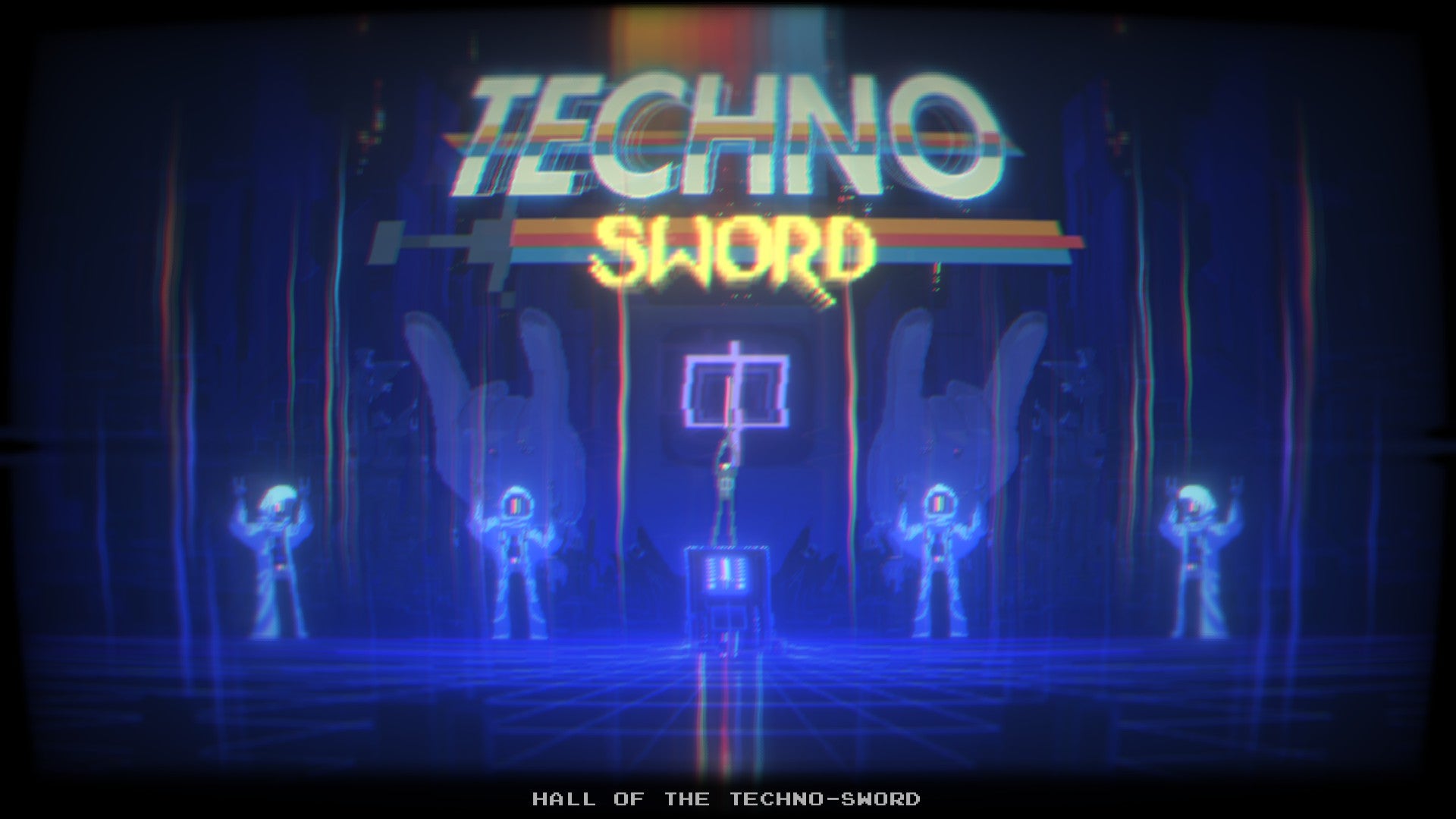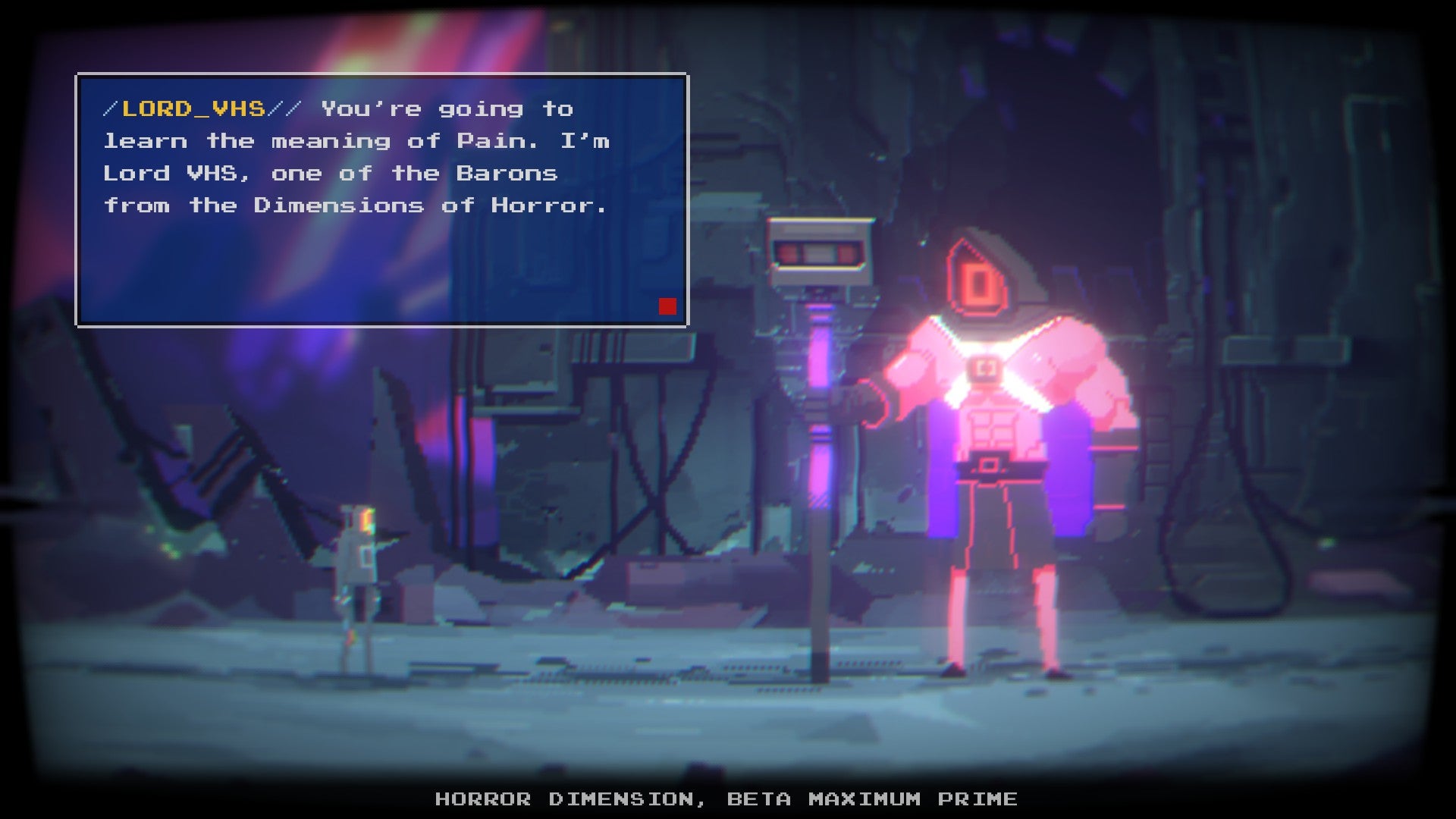You play as the titular Narita Boy, a game-obsessed lad who’s been called into a world known as the Digital Kingdom to save it from ruin and corruption. Literally, in the case of the latter, as a mysterious rogue entity known as HIM (yes, in all-caps) has started infecting this place with corrupted code that’s slowly destroying all the programs and protocols that live inside this 80s-infused digiscape, as well as the memories of the Digital Kingdom’s creator. And when that happens, the Digital Kingdom will be lost forever. It’s a world where coding and computer science have been given the cool 80s treatment of a Saturday morning cartoon, where Trojan viruses are reimagined as swaggering Stallions (geddit?) and the all-seeing, all-knowing Motherboard is a robed, womanly seer. Your trusty Techno Sword has a distinct anime-esque Power Rangers vibe to it as well, as this multi-purpose weapon is both a sword, shotgun, baseball bat and whacking great laser beam all in one. That might seem a bit overkill at first glance, but when you learn early-on in the game that the Digital Kingdom’s creator once hailed from Japan (and the city of Narita, it turns out), it’s one of the many elements of Narita Boy that suddenly clicks into place. It’s a game that knows 100% what it’s about, where everything you see and hear is there for a reason, and where all the extraneous, rose-tinted fat has been excised to create a lean, laser-targeted platforming adventure that’s both a love letter to all things PC and the wider landscape of the era. I’m still the midst of working my way through Narita Boy, but picking apart its melting pot of pop culture references is often just as satisfying as its side-scrolling combat. Indeed, when its heavy battle synths kick in and the camera locks you in to one of its tight battle arenas, Narita Boy’s elegant fighting style wouldn’t look out of place in one of those flashy cartoon showdowns. He doesn’t hit particularly hard, but the way he dances and dodges across the screen, getting in a sneaky jab here and a small shotgun blast there, makes every encounter feel like some kind a violent disco, with enemy corpses erupting in gooey red code explosions instead of bathing the floors with blood. It’s a game that relies a lot on memorising enemy attack patterns, but most are telegraphed clearly in advance and the game’s steady drip feed of new powers does a good job of keeping you on your toes and keeping battles feeling fresh. Bosses are pretty spectacular, too, posing meaty challenges that nicely book-end its clearly defined story beats. Indeed, while some have described it as a Metroidvania, Narita Boy is a much more linear affair than it first appears. There’s no map, for starters, and while each area involves a bit of back-tracking and finding lots of colour-coded door keys, you never really return to those places once you’ve moved on to the next one. A Metroid-like in miniature, if you will, but nothing more. And that’s fine, if you ask me, because it keeps Narita Boy moving forward, allowing it to charge headlong into whatever rad madness it’s got cooked up next. In fact, I find it refreshing how upfront it is about what there is to do in each area, including whether there are any of its very few collectibles to pick up as well. For exmaple, there are 13 creator memories you can visit in Narita Boy to understand how the Digital Kingdom came to be, and you’ll need to visit 12 of them to restore the world’s source code and defeat the evil HIM. You’ll visit most of them as part of the story, but the final one has been completely corrupted, and you’ll need to find five back-up floppy disks before you can view it. These five disks are the only extra collectibles in the whole of Narita Boy, and being told by a character that, “Hey, I’ve got one of these!” allows you to focus your exploration efforts much more keenly rather than endlessly worrying about whether you’ve missed something. If more games adopted this kind of open approach to collectibles, I’d be very happy indeed. As I said earlier, I’ve still got quite a bit of Narita Boy left to play at time of writing, but so far I love everything about it. I love how invested and committed it is to its 80s retro aesthetic, and every reference to an old bit of tech from my youth makes me smile with glee. Some will no doubt find it all a bit too much, its Trichroma Beams and rogue Supervisor Programs sounding like nothing but a non-stop parade of meaningless techno jargon. But for me it’s 100% my bag, and if you like the sound of what I’ve written here, I suspect it will probably be your bag too.

